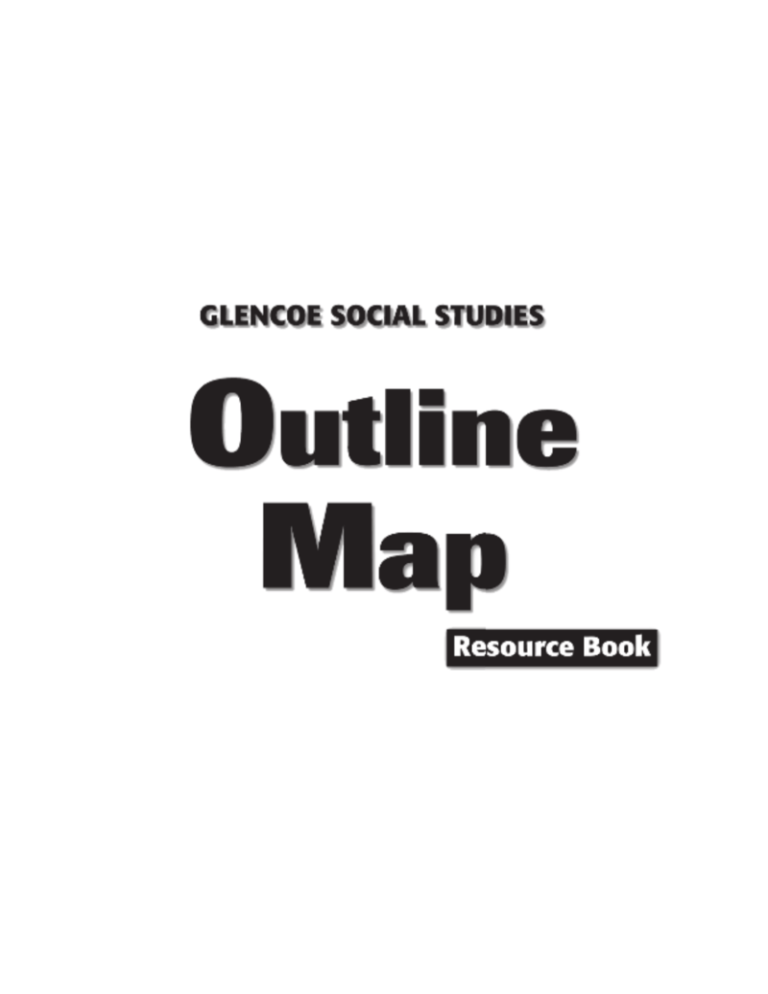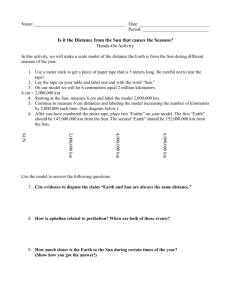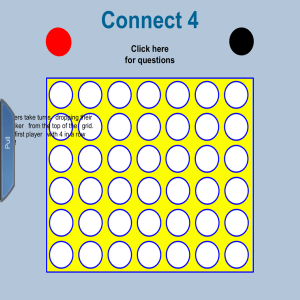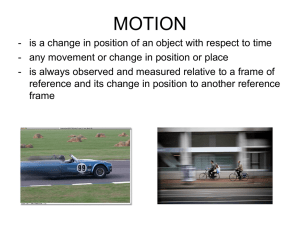
Copyright © by The McGraw-Hill Companies, Inc. All rights reserved. Permission is granted to reproduce the
material contained herein on the condition that such materials be reproduced only for classroom use; be provided to students, teachers, and families without charge; and be used solely in conjunction with the Exploring
Our World program. Any other reproduction, for sale or other use, is expressly prohibited.
Send all inquiries to:
Glencoe/McGraw-Hill
8787 Orion Place
Columbus, OH 43240-4027
ISBN: 0-07-877708-9
ISBN: 9780078777080
Printed in the United States of America.
1 2 3 4 5 6 7 8 9 10 009 11 10 09 08 07
Contents
Introduction
Uses for Outline Maps
Selected Activities for Outline Maps
Outline Maps
1
2
3
United States (blank)
5
United States (with state boundaries)
6
United States (with major river systems)
7
United States (with Alaska and Hawaii correctly placed)
8
Thirteen Colonies (with colonial boundaries)
9
Eastern United States (blank)
10
Eastern United States (with state boundaries)
11
Western United States (blank)
12
Western United States (with state boundaries)
13
The North (with state boundaries)
14
The South (with state boundaries)
15
New England States (with state boundaries)
16
Middle Atlantic States (with state boundaries)
17
South Atlantic States (with state boundaries)
18
South Central and Gulf States (with state boundaries)
19
North Central Plains States (with state boundaries)
20
Rocky Mountain and Pacific States (with state boundaries)
21
Canada (with province and territory boundaries)
22
North America (blank)
23
North America (with national boundaries)
24
North America, 1754
25
South America (blank)
26
South America (with national boundaries)
27
Latin America (with national boundaries)
28
Latin America, 1803
29
iii
iv
Central America and the Caribbean (with national boundaries)
30
Mexico (blank)
31
Mexico (with state boundaries)
32
Western Hemisphere (with rivers)
33
Eastern Hemisphere (with rivers)
34
Europe (blank)
35
Europe (with national boundaries)
36
Medieval Europe, 1160
37
Napoleonic Europe
38
Europe, 1914
39
Europe, 1919−1939
40
Europe, 1945−1989
41
Russia (with national boundaries)
42
Former Soviet Union
43
North Africa, Southwest Asia, and Central Asia (blank)
44
North Africa, Southwest Asia, and Central Asia
(with national boundaries)
45
River Valley Civilizations
46
Ancient Mediterranean World
47
Asia (blank)
48
Asia (with national boundaries)
49
East Asia (with national boundaries)
50
South Asia (with national boundaries)
51
Southeast Asia (with national boundaries)
52
Southern Asia, c. 1900
53
Africa (blank)
54
Africa (with national boundaries)
55
Africa South of the Sahara (with national boundaries)
56
Africa, c. 1914
57
Australia, Oceania, and Antarctica
58
The World (blank)
59
Introduction
O
Students enjoy using outline maps as hands-on
activities that stimulate interest and provide variety
in the classroom. Outline maps invite students to
create their own learning materials. Students can
use the maps they create as they prepare for various
assessments.
The outline maps provided in this book are valuable learning aids because of their flexibility. They
are inexpensive and easy to use. The same map can
be used for several topics in one chapter, or even for
several different courses.
Copyright © by The McGraw-Hill Companies, Inc.
utline maps are among the most valuable tools
available to social studies teachers today. All
areas of the social studies curriculum can benefit by
using outline maps.
Outline maps provide a visual image of information. Studies have shown that most students learn
better when they can visualize material. Outline maps
also provide a context for understanding the world
in spatial terms. As students add details to the basic
outline maps, they are actively organizing information in spatial terms. They can explore the physical
characteristics of places such as landforms, bodies
of water, and vegetation.
1
Uses for
Outline Maps
O
utline maps are teaching aids that can broaden
classroom experiences. How can teachers best
determine ways to use these tools? The following
information suggests a few ways to approach the
use of outline maps in social studies classrooms.
Practicing Map Skills
Recent reports note an alarming decline in the ability of students to use basic map skills. These basic skills
include using scales and legends, determining longitude and latitude, understanding relative and exact
location, and identifying symbols. Standardized tests
are now requiring that students acquire some degree
of map knowledge.
Rather than placing the entire burden of teaching
map skills on geography teachers, other social studies
teachers can help in this effort. All social studies teaching can be enhanced through the use of outline maps.
Developing Perspectives
Noting Patterns and Trends
Maps can put complex statistics and factual information into a readily understandable form. Statistics
about the amounts and locations of oil and natural gas
reserves throughout the world might leave students
2
Recognizing Change
Another difficult concept for students is the idea
of change. Politics, the environment, and society are
constantly shifting. Outline maps are perfect for showing “before” and “after” pictures. A teacher might use
an outline map to show changing political borders,
such as those of Poland before and after World War II.
An outline map could be used to show the shifting of
the American population to the Sunbelt areas of our
country. Maps also can be used to show geographical
changes, such as the erosion of seashores by the oceans
or the alteration of landscapes by glacier movements.
Perfecting Social Studies Skills
Besides helping students learn specific course content, maps can help students perfect their social studies skills. For example, once information about the
distribution of natural resources throughout the world
is pictured on a map, students can be asked to draw
conclusions of their own.
Some students may suggest that resources are
unevenly distributed and, therefore, must be shared
among countries. Others may realize that many
resources are available in areas of the world that are
undeveloped, therefore suggesting the need for exploration. Drawing conclusions, a critical thinking skill, is
only one example of the skills developed by discovery learning. Other skills that can be developed using
outline maps include making inferences, making generalizations, classifying information, predicting consequences, and evaluating information.
Copyright © by The McGraw-Hill Companies, Inc.
As visual tools, maps help students develop perspective. Using maps, students can learn basic personal perspectives. They can identify where their city, county, state,
and country are located within the broader world picture.
Then, relationships and higher-level concepts can
surface. Using maps to teach a history lesson on the
Cold War, students can see how far their homes are
from the former Soviet Union. They may also realize
how close Alaska is to the former Soviet Union. They
can then begin to understand concepts such as “spheres
of influence.”
Students can use outline maps to compare and
contrast land areas and bodies of water. They can also
analyze location and distances. They can explore such
questions as: How does the size of the United States
compare with the size of Australia? How close is the
southern tip of Chile to the South Pole?
without a clear picture of what those figures mean. A
resource map would clearly show students that (a) the
countries of the Middle East have the largest reserves,
and (b) some places in the world completely lack in
those resources.
A list showing Electoral College votes by state for
each presidential candidate gives the basic facts. A
map that uses color to show which states each candidate won expresses the election results in an effective
way. Using such maps for several elections, students
can readily see voting patterns emerge.
Selected Activities
for Outline Maps
Copyright © by The McGraw-Hill Companies, Inc.
World History
1. Locate and label the centers of early civilizations in
Mesopotamia, Egypt, India, China, Africa, and the
Americas.
2. Create thematic maps representing various aspects
of world history such as the spread of Greek and
Roman civilizations; major trade routes that linked
Europe, the Islamic world, and East Asia; and the
rise and fall of the great African empires such as
Ghana, Mali, and Songhai.
3. Locate and label places and regions of historical significance such as the Indus, Nile, Tigris and Euphrates, and Huang He River valleys, and describe their
physical characteristics.
4. Locate and analyze the effects of human geography, such as the impact the building of the Suez
and Panama Canals had on world trade patterns.
5. Use maps to interpret and explain geographic factors such as how the control of the Strait of Hormuz
has influenced people and events in the past.
6. Explore the changes that occurred in the countries
of eastern Europe during the twentieth century.
American History
1. Trace principal voyages of exploration from Europe
to the Americas by such adventurers as Columbus,
Vespucci, Cabot, Hudson, and Cartier.
2. Create thematic maps representing various aspects
of American history. For example, identify the areas
of the Americas claimed and settled by the world
powers active in the exploration and colonization
of the Western Hemisphere. Show the changing
transportation patterns that resulted from the interstate highway system.
3. Create maps showing changes in political boundaries that resulted from statehood and international conflicts such as the territories granted
to the United States at the end of various wars.
4. Identify changes in population and the physical features of the country that influenced these changes.
5. Trace major military campaigns during wars such
as the French and Indian War, the Revolutionary
War, and the Civil War.
6. Outline and label the major territorial acquisitions
of the United States from 1776 to the present.
7. Identify the order in which states were granted
statehood.
8. Trace the routes followed by adventurers such as
Lewis and Clark.
9. Identify locations of U.S. military conflicts and wars
such as Vietnam, Korea, the Persian Gulf, Bosnia
and Herzegovina, Afghanistan, and Iraq.
Government and Civics
1. Locate physical features that are affected by government policies in various regions or places.
2. Use color or shading to compare the seats in the
House of Representatives before and after the 2000
census.
3. Use color and labeling to show the percentage of
voting-age population by state that participated
in presidential elections.
4. Use color and labeling to show the state-by-state
results of presidential elections. Identify any notable voting patterns by region.
5. Identify changes in population among the states and
the effect of these changes on government policies.
6. Identify states voting “for” or “against” a constitutional amendment. Identify any notable regional
voting patterns.
7. Identify and label the percentages of ethnic or cultural groups found in various states or regions.
3
Geography
Economics
1. Locate and label major ocean currents and wind
patterns on a world map.
2. Use distinctive colors to show population densities
in various regions of the world.
3. Outline and label the seven physical regions of the
United States.
4. Locate and label major landforms such as mountain ranges, deserts, and bodies of water.
5. Locate and label countries and their capitals.
6. Label various physical regions of the world by climate and vegetation.
7. Label various regions of the world by human factors such as language and religion.
8. Locate and label major historical and contemporary
societies.
9. Create thematic maps representing such things as
population distribution, economic activities, and
natural resources.
1. Outline and number the regions of the United States
Federal Reserve districts. Then, locate the bank and
branch cities within each region.
2. Label the general sales tax rate for each state of the
United States.
3. Label each state’s minimum wage.
4. Locate and label the natural resources available
in various regions of the world, and analyze the
impact of natural resource allocation on the wealth
of countries in the region.
5. Locate and label the literacy rates of various
countries in a region.
6. On a world map, use color to identify developed
and developing countries of the world.
7. Use colors to identify the levels of imports to and
exports from the United States.
Copyright © by The McGraw-Hill Companies, Inc.
4
0
0
325
325
750 miles
750 kilometers
0
0
100 miles
100 kilometers
Copyright © by The McGraw-Hill Companies, Inc.
0
0
200
200
400 miles
400 kilometers
W
N
S
E
UNITED STATES (blank)
5
0
0
325
325
750 miles
750 kilometers
0
0
100 miles
100 kilometers
Copyright © by The McGraw-Hill Companies, Inc.
6
0
0
200
400 miles
400 kilometers
200
W
N
S
E
UNITED STATES (with state boundaries)
0
0
325
325
750 miles
750 kilometers
0
0
100 miles
100 kilometers
Copyright © by The McGraw-Hill Companies, Inc.
0
0
200
200
400 miles
400 kilometers
W
N
S
E
UNITED STATES (with major river systems)
7
E
W
S
N
8
800 miles
0
Copyright © by The McGraw-Hill Companies, Inc.
0
400
400
800 kilometers
UNITED STATES (with Alaska and Hawaii correctly placed)
Copyright © by The McGraw-Hill Companies, Inc.
THIRTEEN COLONIES (with colonial boundaries)
N
E
W
S
0
0
200
400 kilometers
200
400 miles
9
EASTERN UNITED STATES (blank)
N
E
W
S
0
10
200
400 kilometers
200
400 miles
Copyright © by The McGraw-Hill Companies, Inc.
0
EASTERN UNITED STATES (with state boundaries)
N
E
W
Copyright © by The McGraw-Hill Companies, Inc.
S
0
0
200
400 kilometers
200
400 miles
11
12
0
0
S
150
W
150
E
300 kilometers
300 miles
Copyright © by The McGraw-Hill Companies, Inc.
N
WESTERN UNITED STATES (blank)
0
0
S
150
W
150
N
300 miles
300 kilometers
E
Copyright © by The McGraw-Hill Companies, Inc.
WESTERN UNITED STATES (with state boundaries)
13
Copyright © by The McGraw-Hill Companies, Inc.
14
0
0
200
200
400 kilometers
400 miles
W
S
N
E
THE NORTH (with state boundaries)
Copyright © by The McGraw-Hill Companies, Inc.
0
0
200
200
400 kilometers
400 miles
W
S
N
E
THE SOUTH (with state boundaries)
15
NEW ENGLAND STATES (with state boundaries)
E
W
S
0
0
16
25
50 kilometers
25
50 miles
Copyright © by The McGraw-Hill Companies, Inc.
N
Copyright © by The McGraw-Hill Companies, Inc.
MIDDLE ATLANTIC STATES (with state boundaries)
N
E
W
S
0
0
50
100 kilometers
50
100 miles
17
SOUTH ATLANTIC STATES (with state boundaries)
N
E
W
S
Copyright © by The McGraw-Hill Companies, Inc.
0
0
18
100
200 kilometers
100
200 miles
Copyright © by The McGraw-Hill Companies, Inc.
0
0
125
125
250 miles
250 kilometers
W
S
N
E
SOUTH CENTRAL AND GULF STATES (with state boundaries)
19
S
E
W
N
200 miles
100
100
0
0
200 kilometers
NORTH CENTRAL PLAINS STATES (with state boundaries)
Copyright © by The McGraw-Hill Companies, Inc.
20
Copyright © by The McGraw-Hill Companies, Inc.
ROCKY MOUNTAIN AND PACIFIC STATES (with state boundaries)
N
W
E
S
0
0
200
400 kilometers
200
400 miles
21
300 miles
150
0
0
150
300 kilometers
W
N
S
E
CANADA (with province and territory boundaries)
Copyright © by The McGraw-Hill Companies, Inc.
22
Copyright © by The McGraw-Hill Companies, Inc.
NORTH AMERICA (blank)
N
W
E
S
0
0
400
800 kilometers
400
800 miles
23
NORTH AMERICA (with national boundaries)
W
E
S
0
0
24
400
800 kilometers
400
800 miles
Copyright © by The McGraw-Hill Companies, Inc.
N
Copyright © by The McGraw-Hill Companies, Inc.
NORTH AMERICA, 1754
N
W
E
S
Colonial Empires
Spain
France
Britain
0
0
400
800 kilometers
400
800 miles
25
SOUTH AMERICA (blank)
W
E
S
0
0
26
250
500 kilometers
250
500 miles
Copyright © by The McGraw-Hill Companies, Inc.
N
Copyright © by The McGraw-Hill Companies, Inc.
SOUTH AMERICA (with national boundaries)
N
W
E
S
0
0
250
500 kilometers
250
500 miles
27
LATIN AMERICA (with national boundaries)
W
E
S
0
0
28
500
1,000 kilometers
500
1,000 miles
Copyright © by The McGraw-Hill Companies, Inc.
N
Copyright © by The McGraw-Hill Companies, Inc.
LATIN AMERICA, 1803
N
W
E
S
Colonial Empires
Spain
Portugal
Britain
France
0
0
500
1,000 kilometers
500
1,000 miles
29
500 kilometers
250
E
250
0
0
W
S
N
30
Copyright © by The McGraw-Hill Companies, Inc.
500 miles
CENTRAL AMERICA AND THE CARIBBEAN (with national boundaries)
0
0
W
S
N
250
E
250
500 miles
500 kilometers
Copyright © by The McGraw-Hill Companies, Inc.
Key
Warsaw Pact member
Communist nation
outside Soviet bloc
Neutral nation
NATO member
MEXICO (blank)
31
32
W
S
E
0
0
125
250 miles
250 kilometers
125
Copyright © by The McGraw-Hill Companies, Inc.
N
MEXICO (with state boundaries)
WESTERN HEMISPHERE (with rivers)
Copyright © by The McGraw-Hill Companies, Inc.
N
W
E
S
0
0
750 1,500 kilometers
750
1,500 miles
33
Copyright © by The McGraw-Hill Companies, Inc.
34
W
S
N
E
0
0
750
1,500 miles
750 1,500 kilometers
EASTERN HEMISPHERE (with rivers)
0
0
W
S
N
250
E
250
500 miles
500 kilometers
Copyright © by The McGraw-Hill Companies, Inc.
EUROPE (blank)
35
36
0
W
S
N
250
E
250
500 kilometers
500 miles
Copyright © by The McGraw-Hill Companies, Inc.
0
EUROPE (with national boundaries)
0
0
W
S
N
250
E
250
500 miles
500 kilometers
Copyright © by The McGraw-Hill Companies, Inc.
Holy Roman Empire
Kingdom of the Franks
Kingdom of England
Kingdom of León
Kingdom of Castile
Kingdom of Aragon
Kingdom of Navarre
Kingdom of Scotland
Kingdom of Denmark
Kingdom of Norway
Kingdom of Sweden
Kingdom of Poland
Prussia
Kingdom of Hungary
Papal States
Kingdom of Sicily
Byzantine Empire
Muslim Territory
Europe, 1160
MEDIEVAL EUROPE, 1160
37
0
0
W
S
N
250
E
250
500 miles
500 kilometers
Copyright © by The McGraw-Hill Companies, Inc.
38
1812
French Empire
Dependent states
States allied with
Napoleon
States allied against
Napoleon
NAPOLEONIC EUROPE
0
0
W
S
N
250
E
250
500 miles
500 kilometers
Copyright © by The McGraw-Hill Companies, Inc.
EUROPE, 1914
39
40
0
W
S
N
250
E
250
500 kilometers
500 miles
Copyright © by The McGraw-Hill Companies, Inc.
0
EUROPE, 1919–1939
0
0
W
S
N
250
E
250
500 miles
500 kilometers
Copyright © by The McGraw-Hill Companies, Inc.
Key
Warsaw Pact member
Communist nation
outside Soviet bloc
Neutral nation
NATO member
EUROPE, 1945–1989
41
42
0
300
600 miles
600 kilometers
300
Copyright © by The McGraw-Hill Companies, Inc.
0
W
N
S
E
RUSSIA (with national boundaries)
Copyright © by The McGraw-Hill Companies, Inc.
0
0
500
500
1,000 miles
1,000 kilometers
W
N
S
E
FORMER SOVIET UNION
43
W
S
N
44
1,000 miles
500
0
Copyright © by The McGraw-Hill Companies, Inc.
E
0
500
1,000 kilometers
NORTH AFRICA, SOUTHWEST ASIA, AND CENTRAL ASIA (blank)
W
S
N
E
Copyright © by The McGraw-Hill Companies, Inc.
0
0
500
1,000 miles
1,000 kilometers
500
NORTH AFRICA, SOUTHWEST ASIA, AND CENTRAL ASIA (with national boundaries)
45
Key
Fertile Crescent 3500 B.C.
Ancient Egypt 3100 B.C.
Indus River Valley 2500 B.C.
Shang Dynasty 1700 B.C.
Copyright © by The McGraw-Hill Companies, Inc.
46
W
S
N
E
0
0
750
750
1,500 kilometers
1,500 miles
RIVER VALLEY CIVILIZATIONS
0
0
W
500 miles
500 kilometers
Key
250
E
Roman Empire
Kingdoms of Israel
Growth of Christianity
250
S
N
Copyright © by The McGraw-Hill Companies, Inc.
ANCIENT MEDITERRANEAN WORLD
47
0
0
500
1,000 miles
1,000 kilometers
500
Copyright © by The McGraw-Hill Companies, Inc.
48
W
N
S
E
ASIA (blank)
0
0
500
500
1,000 miles
1,000 kilometers
Copyright © by The McGraw-Hill Companies, Inc.
W
N
S
E
ASIA (with national boundaries)
49
EAST ASIA (with national boundaries)
N
E
W
S
Copyright © by The McGraw-Hill Companies, Inc.
0
0
50
500
1,000 kilometers
500
1,000 miles
SOUTH ASIA (with national boundaries)
N
E
Copyright © by The McGraw-Hill Companies, Inc.
W
0
0
250
S
500 kilometers
250
500 miles
51
52
0
250
250
500 kilometers
500 miles
Copyright © by The McGraw-Hill Companies, Inc.
0
W
S
N
E
SOUTHEAST ASIA (with national boundaries)
0
0
Key
British
Dutch
French
German
Japanese
Portugese
United States
750
750
1,500 kilometers
1,500 miles
Copyright © by The McGraw-Hill Companies, Inc.
W
S
N
E
SOUTHERN ASIA, c. 1900
53
AFRICA (blank)
W
E
S
0
0
54
500
1,000 kilometers
500
1,000 miles
Copyright © by The McGraw-Hill Companies, Inc.
N
Copyright © by The McGraw-Hill Companies, Inc.
AFRICA (with national boundaries)
N
W
E
S
0
0
500
1,000 kilometers
500
1,000 miles
55
AFRICA SOUTH OF THE SAHARA (with national boundaries)
W
E
S
0
0
56
500
1,000 kilometers
500
1,000 miles
Copyright © by The McGraw-Hill Companies, Inc.
N
Copyright © by The McGraw-Hill Companies, Inc.
AFRICA, c. 1914
N
W
E
S
Key
0
0
500
1,000 kilometers
500
1,000 miles
Belgian
British
French
German
Independent
Italian
Portugese
Spanish
57
500
Copyright © by The McGraw-Hill Companies, Inc.
58
0
0
500
1,000 miles
1,000 kilometers
250 kilometers
250 miles
E
0
S
0
W
N
AUSTRALIA, OCEANIA, AND ANTARCTICA
W
S
N
E
Copyright © by The McGraw-Hill Companies, Inc.
0
0
3,000 miles
3,000 kilometers
1,500
1,500
THE WORLD (blank)
59








